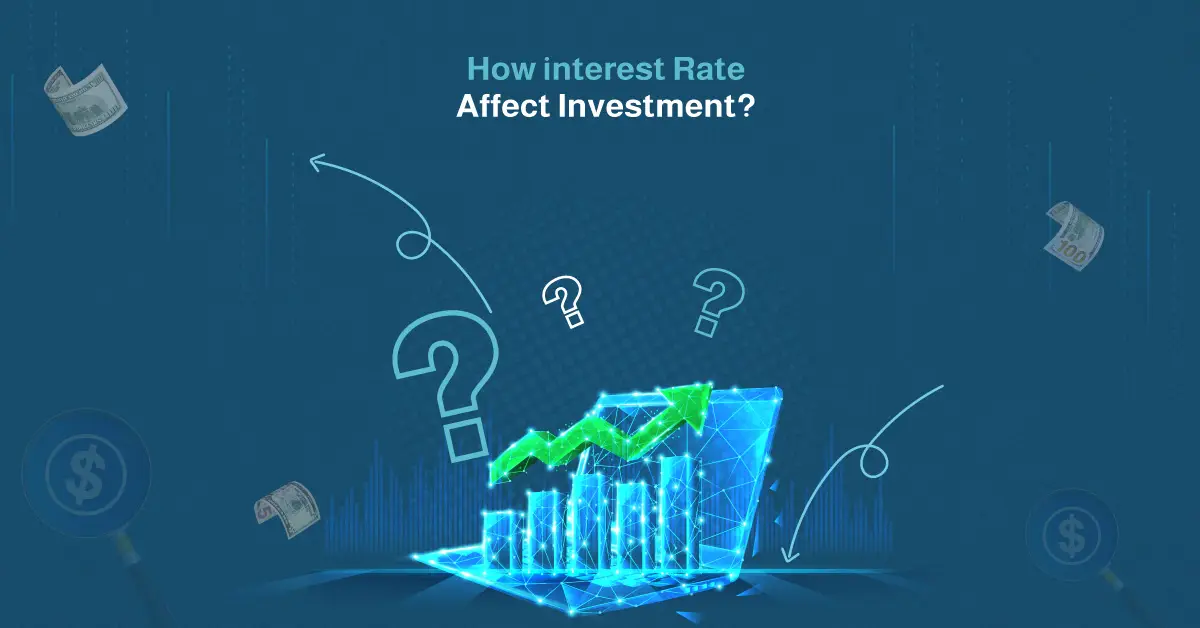Understanding how interest rates affect investment is important for all investors, no matter if you are a beginner, a young professional, or a portfolio manager. This is because interest rates shape the financial landscape more than any other factor. Interest rates affect borrowing costs, savings returns, and the performance of nearly every asset class.
In basic terms, the interest rate represents the price of money. When the price is adjusted by the central banks, this will influence how much it costs businesses and individuals to borrow and how attractive it is to save. Changes to the interest rates will have knock-on effects for the economy, impacting company earnings, market sentiment, and long-term growth. These increases in interest rates will often slow down borrowing and spending. When interest rates are lower, investment is usually encouraged and fuel demand.
The different asset classes have unique responses to changes in the interest rate, which can be problematic for investors. Having an understanding of these challenges as an investor will help you adjust your strategies, balance risks, and identify opportunities.
In this blog, we will explore how interest rates affect investment across asset classes, outline strategies for navigating these capricious systems, and look at alternative methods for diversification. These lessons will apply globally, but we will also consider insights more relevant to Saudi Arabia and the wider MENA region.
More topics can be read on the Gamma blog
Understanding interest rates and their role in the economy
Interest rates have been described as the backbone of modern economies. This is due to what they represent at their core. The cost of borrowing money and the reward for saving it. Central banks such as the Federal Bank or the Saudi Central Bank (SAMA) set the benchmark rates, and when these rates change, the changes affect households, businesses, and investors globally.
Interest rates are closely associated with inflation and growth. When inflation rates rise exponentially, central banks will try to slow spending and reduce borrowing by increasing interest rates. This will help stabilize prices, but can be detrimental for investment, as loans become more expensive. The inverse is true too, by lowering rates you encourage borrowing, which in turn stimulates business activity and boosts customer demand, but then you run the risk of fueling inflation.
It is also important to distinguish between nominal and real interest rates. Nominal interest rate refers to the number you see on a bank loan or savings account. The real interest rate is the nominal interest rate minus inflation; it shows what you truly gain or lose, and is the most important for investors as it provides them with a clearer picture of potential gains and losses.
Understanding how interest rates affect investment starts with recognizing these relationships. Changes in rates are not just abstract economic events, and they directly affect market behavior, asset valuations, and ultimately, portfolio performance. Understanding the role of interest rates puts you in a better position as an investor to be able to anticipate market shifts and position yourself for long-term success.
How rising and falling interest rates impact stocks and bonds
Stocks and bonds have different reactions to interest rate shifts; knowing this will help you adjust the strategy you use for both.
Bonds move opposite to interest rates. When rates rise, new bonds pay more, and older bonds with lower payouts lose value. When the rates decrease, older bonds paying higher interest will become more attractive, so their prices rise.
Stocks are a little more complicated. The rising interest rates increase borrowing costs for companies, which can have a negative impact on profits. This will often affect growth stocks, as companies are expected to borrow to expand quickly in the future. Value stocks are priced on current performance rather than future growth and tend to be less affected and, in some circumstances, are more appealing when rates rise.
Let us take a look at a simple comparison.
| Asset Class | Rising Interest Rates | Falling Interest Rates |
| Bonds | Prices fall, yields rise | Prices rise, yields fall |
| Growth Stocks | Higher borrowing costs, lower valuations | Lower borrowing costs, higher valuations |
| Value Stocks | Less affected, may become attractive | Can benefit, but growth stocks often outperform. |
Saudi Arabian and global investors will experience similar patterns; local stock markets tend to follow the same logic, though regional factors like oil prices or government spending are also part of the picture.
Understanding how interest rates affect investment in stocks and bonds will help investors create a better picture and realize why diversification is so important. Balancing asset types will help a portfolio weather the ups and downs of a changing rate environment.
Effects on real estate and other investment assets
The changes in interest rates directly affect real estate. When rates rise, the cost of mortgages rises with it, meaning it will be less accessible for new investors. This often means that price growth slows too, along with it, rental yields if there is a drop in demand.
Savings accounts are also likely to be affected. Higher rates mean better returns for savers, and the lower rates make savings less rewarding, which often pushes investors to look elsewhere, ie, stocks or property.
Gold, silver, and other commodities behave differently from other assets. Gold becomes more appealing when rates are low, this is because it is a value-holding product and doesn’t pay interest. Oil and a few other commodities depend on global supply and demand, though rates can indirectly influence prices.
If you are seeking stability amid interest rate fluctuations, real estate-backed options can be helpful. Gamma Assets offers investors opportunities to diversify their portfolios starting from small amounts, helping to mitigate risk even when borrowing costs fluctuate.
Strategies to protect and grow your portfolio amid interest rate changes
By preparing for interest rate shifts, investors can be ahead of the curve and ensure they have strategies in place for such an occasion.
- Diversify across asset classes. Don’t rely on a single type of investment; diversify your portfolio by combining stocks, bonds, real estate, and savings products to help mitigate risk. If stocks are struggling during high interest rates, bonds or real estate may offer steadier returns.
- Focus on quality. Companies with strong balance sheets and low debt are less affected by borrowing costs. Investing in these “safer” businesses would reduce volatility when rates rise.
- Manage debt exposure. Debt is more expensive when interest rates rise. Investors holding highly leveraged assets need to review risks and consider looking into investments that don’t require as much borrowing.
- Take advantage of falling rates. Growth opportunities open up when interest rates drop. To benefit from the drop, investors should rebalance their assets into assets that perform better in low-rate environments, such as growth stocks or real estate.
- Keep a long-term perspective. It is important to remember that interest rate cycles are a normal part of economic movement. Reacting quickly can harm your returns; it is wise to make steady adjustments and be patient for better outcomes.
Combining these strategies can help you, as an investor, better protect your wealth and find opportunities in an ever-shifting interest rate economy.
How Gamma Assets provides stable real estate-backed investment alternatives
Investors seek stability, especially when interest rates change. This stability can come from real estate, which offers steady income and long-term value when compared to other, more volatile assets.
Gamma Assets makes investing in real estate more accessible to all investors by allowing participation with minimal capital, helping investors diversify without the high costs of direct property ownership.
No matter whether rates are rising or falling, real estate-backed opportunities can balance your portfolio. If you are navigating investments in a changing interest rate environment, Gamma Assets offers real estate-backed opportunities starting from minimal capital to help diversify and manage risk.
Understanding how interest rates affect investment is vital for building a resilient portfolio. Rates influence stocks, bonds, real estate, and savings differently; this can cause both challenges and opportunities. Investors who diversify, manage their risk, and remain focused on their long-term goals are better positioned to adapt to fluctuations. With accessible real estate-backed options such as those provided by Gamma Assets, you can maintain stability while navigating an uncertain interest rate.
You can start investing now from the Gamma Asset Investment Platform
FAQ
How do interest rate changes affect stock market returns?
Interest rate changes affect company borrowing costs and investor behavior. Rising rates increase borrowing costs, which can lower profits and weigh on stock prices, especially growth stocks. Falling rates reduce costs, supporting higher valuations and encouraging investment in equities. In MENA markets, both local and global rate trends influence stock performance, so monitoring announcements is key.
Can rising interest rates impact real estate investment profitability?
Yes. Higher rates raise mortgage costs, which can reduce property demand and compress rental yields. Well-located or income-focused real estate can still deliver stable returns, making long-term cash flow a safer strategy. Diversified or tokenized real estate investments in the region can help maintain consistent income despite fluctuations in interest rates.
How can small investors hedge against interest rate fluctuations?
Diversifying across stocks, bonds, and real estate-backed assets helps reduce exposure to interest rate fluctuations. Short-duration fixed-income products are less sensitive to rate changes. Real estate-backed opportunities, such as those offered by Gamma Assets, provide a stable alternative for managing risk and generating consistent returns in a shifting interest rate environment.













